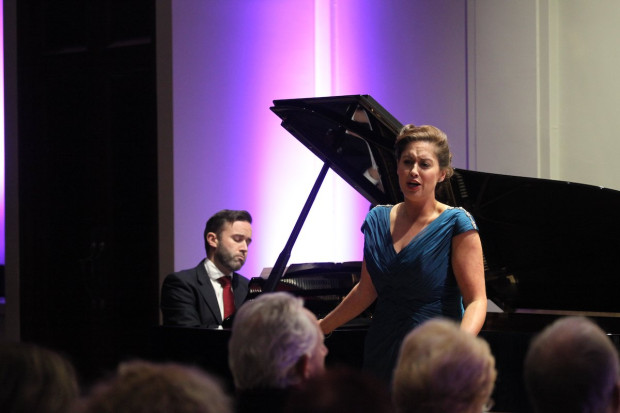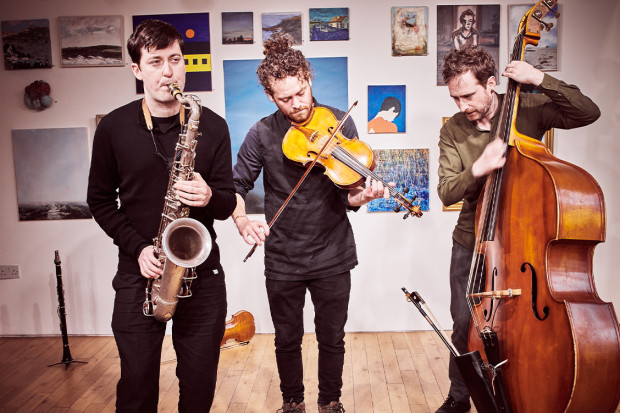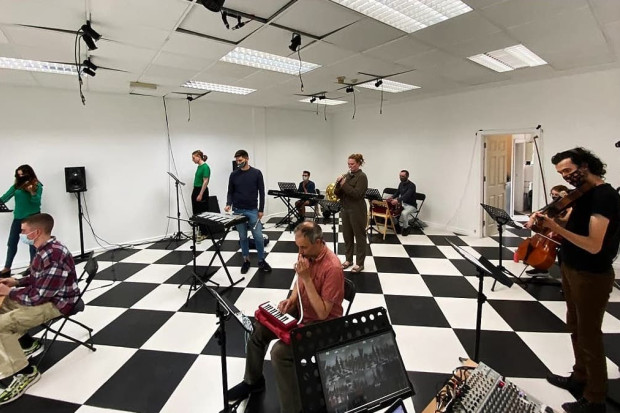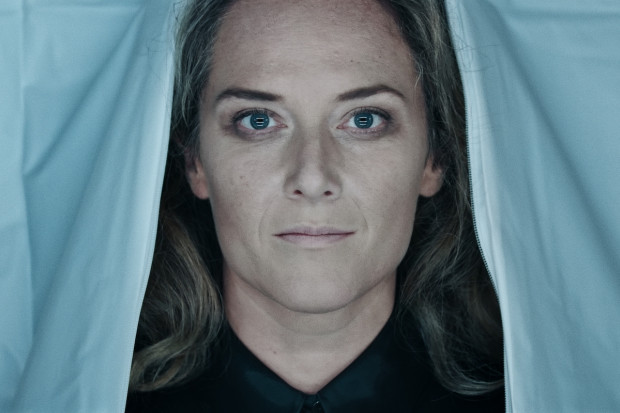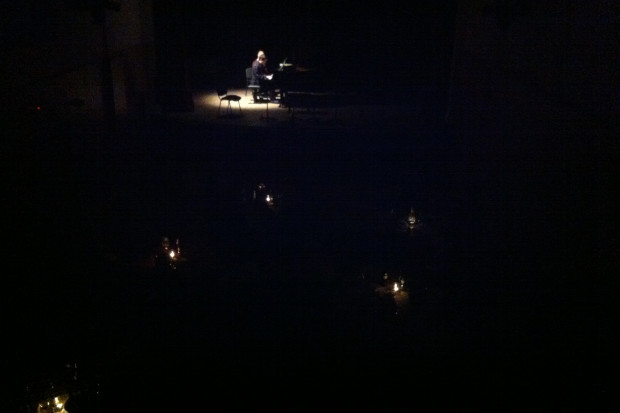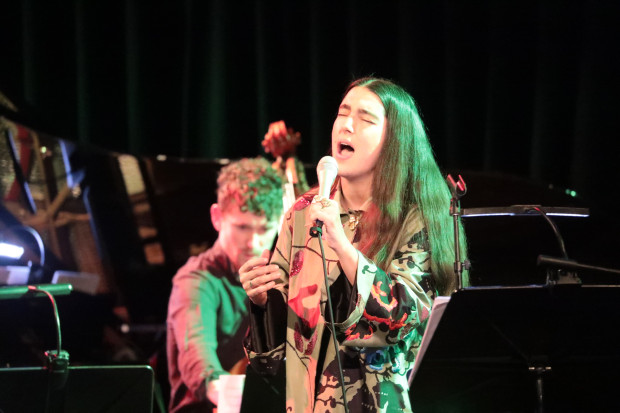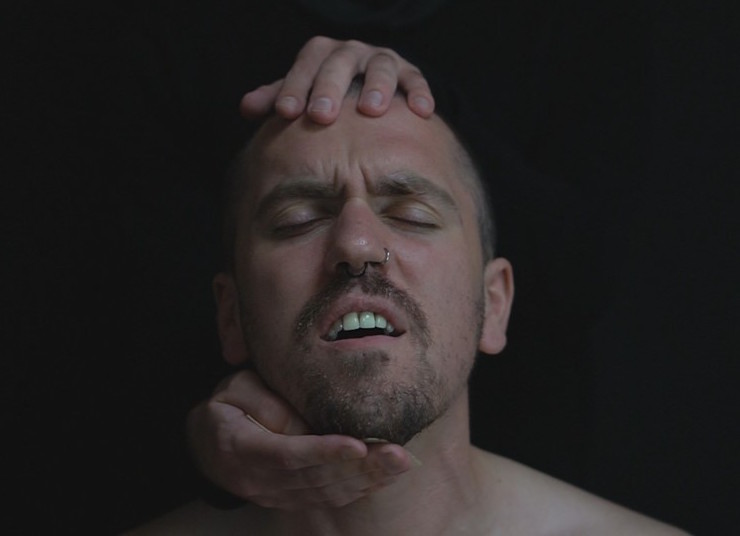
Sam Burton in Robert Coleman’s ‘Cross’
Witness to Suffering
On 21 September, Irish new music group Kirkos presented a concert titled ‘Attrition: A Musical Tribute to a Lost Generation’. Comprising two works by Robert Coleman and Sebastian Adams, founders and directors of the ensemble, the event took place at the Georgian mansion Farmleigh House in the Phoenix Park in Dublin.
Earlier in his career, Adams said he was interested in ‘monumentality and large forms’, as demonstrated by his quartet Harry Patch (2015/2017), which is modelled on Quartet for the End of Time by Messiaen. Lately, however, the composer, who is also a violist, has given more control to performers in works such as 2018.2, which alternates between notated passages and textual instructions for the musicians, and Weight Piece (2018). As for Coleman, the Dublin-born composer has a background in architecture and has created several site-specific pieces such as How many sides do you see? (2019), which explores the relationship between the listener and the sky.
Harry Patch was the main event at Attrition, but, before and after, Coleman’s new work Cross played on three monitors in the conservatory of the house. In this piece, Coleman evokes Thomas Ashe, a leading figure of the Irish Rebellion who went on a hunger strike while imprisoned in 1917. British authorities responded by force-feeding him, which, in part, led to his death.
On the three screens, singer Sam Burton intoned a song called ‘Let me carry your cross for Ireland, Lord’, which Ashe wrote in prison in 1916. The screens created three corners of a cross, which the viewer completed when standing in front of them.
The recording of Burton on the middle screen sang the opening three verses alone. After, Burton on the left screen began the song, but, near the end of the first stanza, two hands came out of the darkness behind him; the left hand grabbed the top of his head, and the right shoved a popadom into his mouth. Even though this force-feeding made Burton choke and cough, he continued to sing; his voice, consequently, sounded muffled and pained.
One could view this scene as a reflection of Ashe’s determination, but more powerful was how Coleman impelled audiences to witness the suffering; the composer made the living come face-to-face with the dead. The contrast between the pleasant conservatory, with its green potted plants, and the brutality of the videos, furthermore heightened a listener’s discomfort. Throughout, Burton’s performance felt haunting and well-inflected; he imbued the song with an appropriate wistfulness.

Robert Coleman’s ‘Cross’ in the conservatory of Farmleigh House
The futility of war
The other work on the programme, Harry Patch, which was performed in the mansion’s ballroom, engaged with the past in other ways. Adams’ quartet, which is named after the longest surviving British soldier who fought in World War I, is a meditation on the futility of war and, the composer says, ‘the tragic unchangeability of the human condition.’ This composition unfolds in eight movements and employs flute, horn, cello, and piano, which were played by Miriam Kaczor, Hannah Miller, Yseult Cooper Stockdale, and Alexander Bernstein.
Adams suffused his quartet with a pervasive melancholy. In the second movement, for instance, Kaczor and Miller spun out forlorn lines that rose and fell in unison. Later, in the sixth movement, Kaczor, playing low in her range, swirled soft and dark flurries that were at times broken by piercing cries – wails of despair in a damaged world.
Like Coleman, Adams incorporated theatricality to great effect. In the third movement, Miller played an extended off-stage solo that featured jagged two-note figures and muted glissandi. Because audience members couldn’t see Miller, it was as if her music was coming from beyond the grave.
Such a spectral presence came across most effectively in the penultimate movement, when Miller performed a horn call that was followed by a recording of her earlier solo. The live performers responded to this disembodied music with softly held chords. Recordings of previous solos from the flute and cello returned as well. These recollections, some of which came from the back of the ballroom and others from the adjoining room on the audience’s left, led to the final movement, in which the piano played a funereal procession over a repeating octave that tolled low in its range. After experiencing this episode of electronic reminiscences – by far the most hair-raising part of the afternoon – and the subsequent elegy on the piano, one sensed a satisfying unity that held the piece together.
In terms of the performance, all four musicians executed their difficult parts with a determined energy. Miller, in particular, deserves praise for her smooth navigation of the third movement, which consisted entirely of her solo and demanded extreme virtuosity.
Although Harry Patch could benefit from some tightening in the writing, especially the horn solo, which sometimes sounded diffuse, and the solo piano ending, which was perhaps too long, the quartet offered a powerful reflection on the tragic repercussions of war. Overall, the thematic connections and convincing renditions resulted in another strong Kirkos concert.
Kirkos’ next concert is the Irish premiere of Cypriot composer Yannis Kyriakides’ opera The Buffer Zone on 6–8 December at the DCC Incubation Space. Visit https://www.facebook.com/kirkosensemble.
Published on 30 October 2019
Tim Diovanni is a music journalist from New York and a graduate student in musicology at the TU Dublin Conservatory of Music and Drama.












